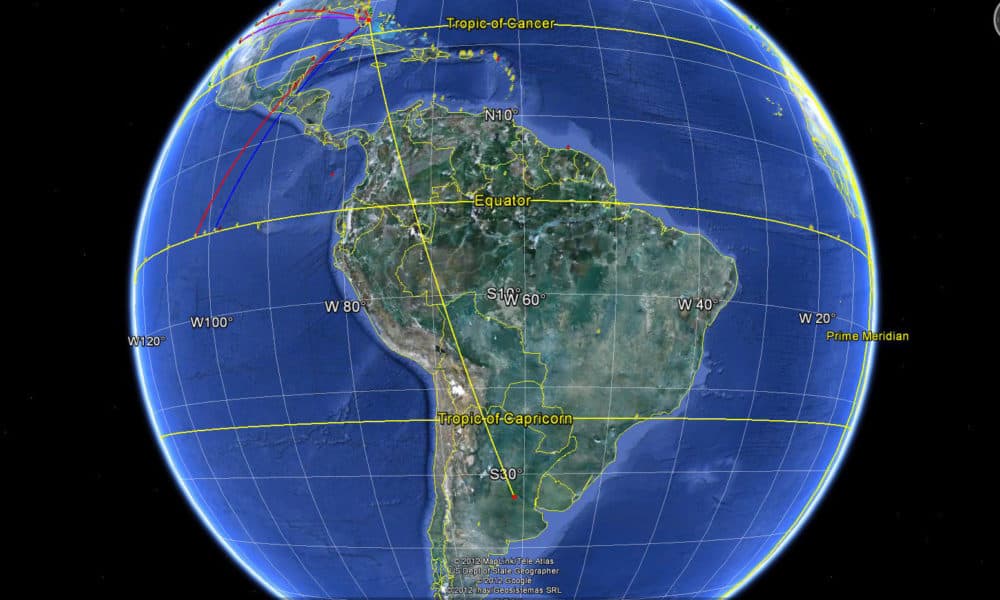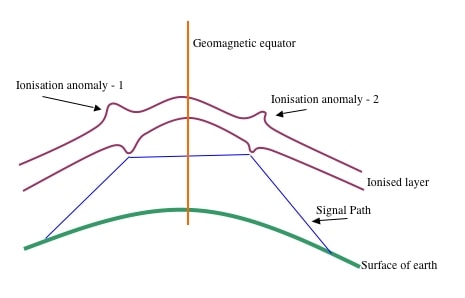Simplified ionospheric models portray the ionosphere as a series of horizontal layers that vary with time, location and sunspot activity. The real ionosphere is much more complex than this, particularly in equatorial and polar regions.
What is Trans-Equatorial Propagation (TEP)?
Historically, the effect was first noticed in the 1940’s by both military and amateur operators who discovered that it is possible to communicate in the VHF band over intercontinental distances during times of high sunspot activity.
The first organized and therefore relatively large scale TEP communications occurred during 1957-1958 in the peak of sunspot cycle 19. Sunspot peaks in 1970 (cycle 20) and 1977 (cycle 21) expanded our knowledge of the phenomenon.
When does TEP occur?
Two distinct types of TEP have been identified:
- those occurring during late afternoon and early evening, and usually over maximum distances of around 6000km. Contacts were restricted to the low VHF bands (6 metres for hams in most countries)
- those occurring around 1900 to 2300 local time, with workable contacts being made on 144MHZ( 2 metres) and sometimes on 432MHz (70 centimeters)
Why does TEP occur over the Equator?
There are three general “zones” in the atmosphere of the Earth, Polar, Temperate and Equatorial. In terms of density, it has been found that equatorial ionospheric areas are denser than those over polar regions.
This affects useable frequencies within those regions. Perhaps because they are at the “extremes” of the earth in terms of their exposure to the effects of the sun, the polar and equatorial regions are subject to various unusual and unexpected variations in ionospheric conditions – these often occurring in the F-Layer.
Perhaps the most interesting of these effects is known as the “equatorial anomaly”. This occurs where a high electron concentration is found on each side of the magnetic equator and is usually seen in the region of 10 to 20 degrees latitude.
Afternoon TEP is believed to occur when a signal is reflected first by an anomaly on one side of the equator and then again by another anomaly on the other side.
Evening TEP is less well understood, but is believed to rely on “ionospheric bubbles” – areas of high ionization density off which signals are reflected.
What are the characteristics of afternoon TEP?
- Maximum useable frequency (MUF) up to about 60 MHz
- It occurs from around 1500 to 1900 local time.
- It is more prevalent near the equinoxes and at times of high sunspot numbers.
- Typical path lengths will be from 5000 to 6500 kilometers.
- Signals will normally be strong with limited fading and distortion
What are the characteristics of evening TEP?
- Occurs around 2000 to 2300 local time, and is more frequent around the equinoxes and especially at times of high sunspot activity
- Signals may have doppler spread
- Signals subject to rapid fading and strong distortion
- Path lengths are usually between 3000 and 8000 kilometers.
Is it possible to predict TEP conditions?
At the moment it is not possible to predict TEP conditions, but the following are indicative that those conditions may be possible.
- The receiver and transmitter should be located at equal distances from the magnetic equator.
- the time is around the equinoxes.
- The path must be within about 15 degrees of geomagnetic north-south.
- the Solar cycle is at a maximum – leading to higher ionospheric ionization.
- The higher the F2 layer is over the geomagnetic equator the higher the occurrence rate of TEP.
- The further the equatorial anomalies are from the geomagnetic equator the higher the probability that afternoon TEP will occur



In EA7 region of southern Spain we have almost daily 6Mtr/50Mhz TEP to PY Brazil at 215 to 220 degrees, +15/20 degrees off of 180/south from around 18:00GMT until 22:00GMT average contacts are around 8,000Km the path does extend some evenings to Uruguay & Argentina and on good evenings to Chile. Watched on PSK reporter the path is very noticeable at just a few degrees wide. This week EA8 Canarie Islands have made contact on this path to New Zealand! TEP is a fascinating mode of propagation.
Year 2022 have been a good year for TEP conditions , in special from March 31 to April 5 , maybe due the double CME impact and SFi goes up 150!!! , Have been posible daily contacts from Balearic Islands(Spain) to Chile,Brazil,Argentina,Paraguay,Uruguay,Venezuela,St Helena, Burkina Faso ,Falkland,Maurice Isl,Reunion isl,South Africa,Kenia,Gabon,Central Africa,also many other even from Greece,Saudi Arabia,Italy ,Spain(EA4,EA1) all of them always with the antena pointing to South , try many time direct for Tropo conditions , but all contacts ave been evenenig time beaming south.
The figure is totally misleading with respect to the nature of the equatorial anomaly. What is known as the Equatorial Ionisation Anomaly arises because of an electric current which flows at the geomagnetic equator. This current is orthogonal to the magnetic field so ExB drift causes the ionisation to be lifted vertically. The electrons then flow down the field lines leading to two bands either side of the equator which have high electron density. It is the electron density gradient which causes radio waves to propagate across the equator without a ground bounce.
Evening TEP modes have there origin in Equatorial Plasma Bubbles which result from a plasma instability. These bubbles can extend to 800 km or more in the ionosphere and extend several thousand kilometres in the NS direction. On a given night, if they form, there will be a chain of these bubbles spaced by several hundred kilometres. The plasma within the bubble is highly disturbed leading to scattering in range, Doppler and azimuth.